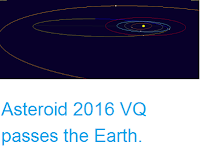Asteroid
2016 WQ1 passed by the Earth at a distance of 899 400 km (2.34 times the
average distance between the Earth and the Moon, 0.60% of the average
distance
between the Earth and the Sun), at about 1.15 am GMT on Saturday 19
November 2016. There was no danger of the asteroid hitting us, though
had it
done so it would have presented no threat. 2016 WQ1 has an estimated
equivalent diameter of 4-16 m (i.e. it is estimated that a spherical
object
with the same volume would be 4-16 m in diameter), and an object of this
size
would be expected to explode in an airburst (an explosion caused by
superheating from friction with the Earth's atmosphere, which is greater
than
that caused by simply falling, due to the orbital momentum of the
asteroid) in
the atmosphere between 43 and 25 km above the ground, with only
fragmentary
material reaching the Earth's surface.
The calculated orbit of 2016 WQ1. Minor Planet Center.
2016 WQ1 was discovered on 20 November 2016 (the day after its closest approach to the Earth) by the
University of Arizona's Mt. Lemmon Survey at the Steward Observatory on Mount
Lemmon in the Catalina Mountains north of Tucson. The designation 2016 WQ1
implies that the asteroid was the 41st object (object Q1) discovered in the second half of November 2016 (period 2016 W).
2016 WQ1 is calculated to have a 886 day orbital
period and an elliptical orbit tilted at an angle of 0.23° to the plain of the
Solar System that takes it from 0.96 AU from the Sun (i.e. 96% of the average
distance at which the Earth orbits the Sun) to 2.65 AU from the Sun (i.e. 265%
of the average distance at which the Earth orbits the Sun, more than the
distance at which the planet Mars orbits the Sun). It is therefore classed as
an Apollo Group Asteroid (an asteroid that is on average further from the Sun
than the Earth, but which does get closer).
See also...
Follow Sciency Thoughts on Facebook.







